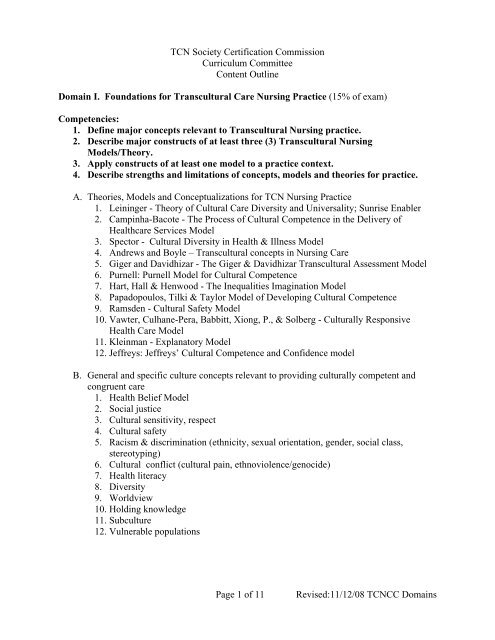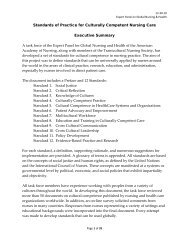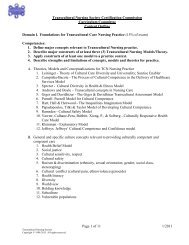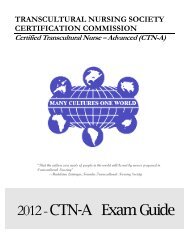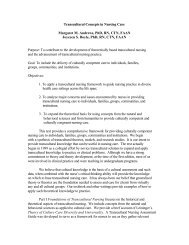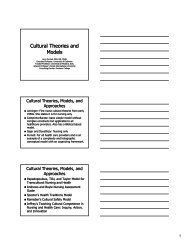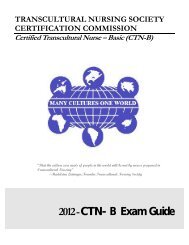of 11 Revised:11/12/08 TCNCC Domains TCN Society Certification ...
of 11 Revised:11/12/08 TCNCC Domains TCN Society Certification ...
of 11 Revised:11/12/08 TCNCC Domains TCN Society Certification ...
You also want an ePaper? Increase the reach of your titles
YUMPU automatically turns print PDFs into web optimized ePapers that Google loves.
<strong>TCN</strong> <strong>Society</strong> <strong>Certification</strong> Commission<br />
Curriculum Committee<br />
Content Outline<br />
Domain I. Foundations for Transcultural Care Nursing Practice (15% <strong>of</strong> exam)<br />
Competencies:<br />
1. Define major concepts relevant to Transcultural Nursing practice.<br />
2. Describe major constructs <strong>of</strong> at least three (3) Transcultural Nursing<br />
Models/Theory.<br />
3. Apply constructs <strong>of</strong> at least one model to a practice context.<br />
4. Describe strengths and limitations <strong>of</strong> concepts, models and theories for practice.<br />
A. Theories, Models and Conceptualizations for <strong>TCN</strong> Nursing Practice<br />
1. Leininger - Theory <strong>of</strong> Cultural Care Diversity and Universality; Sunrise Enabler<br />
2. Campinha-Bacote - The Process <strong>of</strong> Cultural Competence in the Delivery <strong>of</strong><br />
Healthcare Services Model<br />
3. Spector - Cultural Diversity in Health & Illness Model<br />
4. Andrews and Boyle – Transcultural concepts in Nursing Care<br />
5. Giger and Davidhizar - The Giger & Davidhizar Transcultural Assessment Model<br />
6. Purnell: Purnell Model for Cultural Competence<br />
7. Hart, Hall & Henwood - The Inequalities Imagination Model<br />
8. Papadopoulos, Tilki & Taylor Model <strong>of</strong> Developing Cultural Competence<br />
9. Ramsden - Cultural Safety Model<br />
10. Vawter, Culhane-Pera, Babbitt, Xiong, P., & Solberg - Culturally Responsive<br />
Health Care Model<br />
<strong>11</strong>. Kleinman - Explanatory Model<br />
<strong>12</strong>. Jeffreys: Jeffreys’ Cultural Competence and Confidence model<br />
B. General and specific culture concepts relevant to providing culturally competent and<br />
congruent care<br />
1. Health Belief Model<br />
2. Social justice<br />
3. Cultural sensitivity, respect<br />
4. Cultural safety<br />
5. Racism & discrimination (ethnicity, sexual orientation, gender, social class,<br />
stereotyping)<br />
6. Cultural conflict (cultural pain, ethnoviolence/genocide)<br />
7. Health literacy<br />
8. Diversity<br />
9. Worldview<br />
10. Holding knowledge<br />
<strong>11</strong>. Subculture<br />
<strong>12</strong>. Vulnerable populations<br />
Page 1 <strong>of</strong> <strong>11</strong><br />
<strong>Revised</strong>:<strong>11</strong>/<strong>12</strong>/<strong>08</strong> <strong><strong>TCN</strong>CC</strong> <strong>Domains</strong>
Domain II. Culturally-Based Health, Caring, and Healing Practices (20% <strong>of</strong> exam)<br />
Competencies:<br />
1. Compare similarities and differences in values, beliefs, and practices among three<br />
cultural groups across the lifespan.<br />
2. Examine biological variations that impact health care.<br />
3. Address language, communication patterns, and health literacy factors in the<br />
provision <strong>of</strong> nursing care.<br />
A. Influencing Factors<br />
1. Health values, beliefs, and practices<br />
2. Religious and spiritual care<br />
3. Ethical and legal issues<br />
4. Culture-bound illnesses<br />
5. Indigenous healers<br />
6. Folk care/pr<strong>of</strong>essional/popular<br />
7. Complementary and alternative therapy modalities<br />
8. Nutritional patterns<br />
9. Lifespan<br />
10. Physical, biological and physiological variations <strong>of</strong> diverse populations (biological<br />
ecology)<br />
a. Disease incidence and prevalence, including but not limited to:<br />
b. Diabetes and Native American/Appalachian populations<br />
c. Hypertension and Black population<br />
d. Genetic risk factors, including but not limited to:<br />
e. Sickle-cell anemia and Black population<br />
f. Thallasemia and Mediterranean heritage<br />
g. Skin variations<br />
h. Treatment efficacy, including ethnic pharmacology<br />
B. Language and Communication Patterns<br />
1. Artifacts<br />
2. Time: Past, present, and/or future-oriented<br />
3. Family hierarchy<br />
4. Conflict resolution<br />
5. Literacy/Health literacy<br />
6. Teaching-learning principles for diverse populations<br />
7. Communication<br />
a. Environmental and social contexts<br />
b. Privacy and information sharing<br />
c. Verbal Communication<br />
i. Interpreters and translators<br />
ii. Lack <strong>of</strong> English Pr<strong>of</strong>iciency and Limited English Pr<strong>of</strong>iciency (LEP)<br />
iii. Lack <strong>of</strong>, or limited, pr<strong>of</strong>iciency in <strong>of</strong>ficial language(s) <strong>of</strong> country <strong>of</strong><br />
residence<br />
iv. Communicating “bad news”<br />
v. “Saving face”<br />
Page 2 <strong>of</strong> <strong>11</strong><br />
<strong>Revised</strong>:<strong>11</strong>/<strong>12</strong>/<strong>08</strong> <strong><strong>TCN</strong>CC</strong> <strong>Domains</strong>
d. Nonverbal Communication<br />
i. Eye contact<br />
ii. Gestures and expression <strong>of</strong> emotion<br />
iii. Use and meaning <strong>of</strong> silence and touch<br />
iv. Personal space<br />
Domain III. Assessment <strong>of</strong> Cultural Information Relevant to Health Care (10% <strong>of</strong> exam)<br />
Competencies:<br />
1. Demonstrate the use <strong>of</strong> cultural assessment tools, instruments, enablers, guidelines.<br />
2. Utilize principles <strong>of</strong> participant observation in cultural assessment.<br />
3. Synthesize assessment data to discover cultural health patterns.<br />
A. Assessment tools, instruments, enablers, guidelines<br />
B. Guidelines for Assessment <strong>of</strong> Persons from Different Cultures (Ways to interview people,<br />
i.e. the concept <strong>of</strong> respect, birth order, gender issues, key probes, etc)<br />
C. Methods for Conducting Assessment (gathering data)<br />
D. One – One interview (although some cultures do not like to be interviewed alone and<br />
another person may be included during the process)<br />
E. Demonstrate use <strong>of</strong> selection <strong>of</strong> assessment tools:<br />
1. Giger, R. & Davidhizar, J.: Cultural assessment guide: gather data on<br />
communication, space, biological variations, environmental control, time & social<br />
organization.<br />
2. Spector, R.: Appendix D Heritage Assessment Tool<br />
3. Purnell, L. & Paulanka, B.: Model for cultural competence surveys following<br />
domains:<br />
a. Macro aspects: global society, community, family, person, health<br />
domains<br />
b. Overview, inhabited localities, topography<br />
c. Communication<br />
d. Family roles & organization<br />
e. Workforce issues<br />
f. Biocultural ecology<br />
g. High-risk behaviors<br />
h. Nutrition<br />
i. Pregnancy &; childbearing practices<br />
j. Death rituals<br />
k. Spirituality<br />
l. Health-care practices<br />
m. Health-care practitioners<br />
4. Andrews, M. & Boyle, J. (2003): Appendix A Transcultural Nursing Assessment<br />
Guide assesses the following:<br />
a. Biocultural variations & cultural aspects <strong>of</strong> the incidence <strong>of</strong> disease<br />
b. Communication<br />
c. Cultural affiliations<br />
d. Cultural sanctions & restrictions<br />
e. Developmental considerations<br />
Page 3 <strong>of</strong> <strong>11</strong><br />
<strong>Revised</strong>:<strong>11</strong>/<strong>12</strong>/<strong>08</strong> <strong><strong>TCN</strong>CC</strong> <strong>Domains</strong>
F. Cultural Assessment Models<br />
f. Educational background<br />
g. Health-related beliefs & practices<br />
h. Kinship & social networks<br />
i. Nutrition<br />
j. Religious affiliation<br />
k. Values orientation<br />
LEARN Model<br />
Berlin, E., and Fowkes, W. (1982). A teaching framework for cross-cultural health care.<br />
The Western Journal <strong>of</strong> Medicine, 139(6), 934-938.<br />
RESPECT Model<br />
Bigby J.A. (2003). Cross-Cultural Medicine. Philadelphia, PA: American College <strong>of</strong><br />
Physicians.<br />
Bloch’s Assessment Guide for Ethnic/ Cultural Variations Model<br />
Bloch, B. (1983). “Bloch’s Assessment Guide for Ethnic/ Cultural Variations.” In M.<br />
Orque, B. Bloch & L. Monroy (Eds.), Ethnic Nursing Care. St. Louis: C.V. Mosby Co.<br />
LIVE & LEARN Model<br />
Carballeria, N. (1996). The live and learn model for culturally competent family ervices.<br />
Latin American Health Institute, AIA Resource Center, The Source, Volume 6, No. 3.<br />
ESFT Model<br />
Carillo, J., Green, A., and Betancourt, J. (1999). Cross-cultural primary care: A patientbased<br />
approach. Annals <strong>of</strong> Internal Medicine, 130, 829-834.<br />
GREET Model<br />
Chong, N. (2002). The Latino patient: A cultural guide for health care providers.<br />
Yarmouth, ME: Intercultural Press.<br />
BELIEF Model<br />
Dobbie, A., Medrano, M., Tysinger, J., and Olney, C. (2003). The BELIEF instrument:<br />
A preclinical tool to elicit patient’s health beliefs. Family Medicine, 35(5), 316-9.<br />
CONFHER Model<br />
Fong, C. (1985). Ethnicity and nursing practice. Topics in Clinical Nursing, 7(3), 1-10.<br />
Ethnocultural Assessment Model<br />
Jacobsen, F. (1988). “Ethnocultural Assessment.” In L. Comaz-Diaz (Eds.), Clinical<br />
Guidelines in Cross-Cultural Mental Health. NY: Wiley & Sons.<br />
RISK Model<br />
Kagawa-Singer, M., and Kassim-Lakha. (2003). A strategy to reduce cross-cultural<br />
miscommunication and increase the likelihood <strong>of</strong> improving health outcomes. Academic<br />
Medicine, 78: 577-587.<br />
Page 4 <strong>of</strong> <strong>11</strong><br />
<strong>Revised</strong>:<strong>11</strong>/<strong>12</strong>/<strong>08</strong> <strong><strong>TCN</strong>CC</strong> <strong>Domains</strong>
Patient’s Explanatory Model (EM)<br />
Kleinman, A. (1980). Patients and Healers in the Context <strong>of</strong> Culture. CA: University <strong>of</strong><br />
California Press.<br />
ETHNIC Model<br />
Levin, S., Like, R., and Gottlieb, J. (2000). ETHNIC: A Framework for Culturally<br />
Competent Clinical Practice. New Brunswick, NJ: Department <strong>of</strong> Family Medicine,<br />
UMDNJ-Robert Wood Johnson Medical School.<br />
TRANSLATE Model<br />
Like, R. (2000). TRANSLATE: For working with medical interpreters. Patient Care,<br />
34(9), 188.<br />
ADHERE Model<br />
Like, R. (2004). ADHERE: A Mnemonic For Improving Patient Adherence With<br />
herapeutic Regimes. From The Providers’ Guide to Quality and Culture. [Web site]<br />
accessed 10 April 2007 from http://erc.msh.org/quality&culture. Published in Soto-<br />
Greene, M., Salas-Lopez, D., Sanchez, J., and Like, R.C. (2004). Antecedents to<br />
Effective Treatment <strong>of</strong> Hypertension in Hispanic Populations. Clinical Cornerstone,<br />
6(3): 30-36.<br />
INTERPRET Model<br />
Medrano, M., Cominolli, R., Soto-Greene, M., and Debbie Salas-Lopez, D (2002).<br />
From the University <strong>of</strong> Texas Health Science Center at San Antonio and New Jersey<br />
Medical School, The University <strong>of</strong> Medicine and Dentistry <strong>of</strong> New Jersey, Hispanic<br />
Centers <strong>of</strong> Excellence (a HRSA funded Center).<br />
*This work may not be translated or copied in whole or part, transmitted in any<br />
form by any means (electronic or mechanical), including photocopying,<br />
recording, storage in an information retrieval system or otherwise, without the<br />
written permission <strong>of</strong> the authors.<br />
**Please contact Dr. Medrano at medranom@uthscsa.edu to obtain permission.<br />
***Note: Found on page 146 in following document:<br />
Campinha-Bacote, J. et al. (2005). Transforming the Face <strong>of</strong> Health<br />
Pr<strong>of</strong>essions Through Cultural and Linguistic Competence Education: The<br />
Role <strong>of</strong> the HRSA Centers <strong>of</strong> Excellence. Washington, DC: U.S.<br />
Department <strong>of</strong> Health and Human Services, Health Resources and<br />
Services Administration. (link)<br />
http://www.hrsa.gov/culturalcompetence/curriculumguide/<br />
BATHE Model<br />
Stuart, M., and Lieberman, J. (1993). The Fifteen Minute Hour: Applied Psychotherapy<br />
for the Primary Care Physician (2nd ed.). New York, NY: Praeger.<br />
Page 5 <strong>of</strong> <strong>11</strong><br />
<strong>Revised</strong>:<strong>11</strong>/<strong>12</strong>/<strong>08</strong> <strong><strong>TCN</strong>CC</strong> <strong>Domains</strong>
G. Additional Bibliography<br />
Tripp-Reimer, T., Brink, P., & Sanders, J. (1984). Cultural assessment: Content & process.<br />
Nursing Outlook, 32 (2), 78-82.<br />
[I know this is old –but is a classic & has a very good explanation <strong>of</strong> what cultural<br />
assessment is and why it’s done –with a guide for what to assess.]<br />
Brennan, S. & Schulze, M. (2004). Cultural immersion through ethnography: The lived<br />
experience and group process. Journal <strong>of</strong> Nursing Education,43 , 6, 285-288.<br />
Bickman, L. & Rog, D. (eds) (1998) (again, there may be a newer ed). Handbook <strong>of</strong> applied<br />
social research methods Thousand Oaks, CA: Sage.<br />
Chap 16, Ethnography, by David Fetterman<br />
Chap 17, Focus group research: exploration & discovery, by David Stewart & Prem<br />
Shamdasani.<br />
Roper, J. & Shapira, J. (2000). Ethnography in nursing research. Thousand Oaks, CA: Sage.<br />
A. Participant Observation (Participating with, reflecting with, nonverbal communication)<br />
B. Ethnographic interviewing<br />
1. Review secondary data, resources, etc.<br />
2. Observe directly (see for yourself)<br />
3. Seek those who are experts about specific issues<br />
4. Case studies and stories<br />
C. Groups (casual or random encounter; focus representative or structured for diversity;<br />
community, neighborhood or a specific social group; or formal).<br />
1. Do-it-yourself activities (be a part <strong>of</strong> activities in community).<br />
2. Mapping and modeling what you see<br />
3. Timelines and trend and change analysis.<br />
4. Contrast comparisons. Asking group A to analyze group B and vice versa.<br />
D. Community meetings or gatherings<br />
1. Analysis and Synthesizing <strong>of</strong> information gathered<br />
a. Discovering cultural patterns / themes<br />
b. Situated Context <strong>of</strong> care<br />
c. Artifacts<br />
d. Time / space<br />
Domain IV: Culturally-Based Nursing Care (40% <strong>of</strong> exam)<br />
Competencies:<br />
1. Integrate cultural assessment data in the delivery <strong>of</strong> care to individuals, families,<br />
and communities.<br />
2. Build community partnerships and coalitions for culturally congruent care.<br />
3. Analyze health care organizations/systems for cultural competence.<br />
4. Incorporate best evidence into delivery <strong>of</strong> care.<br />
5. Analyze regulatory and pr<strong>of</strong>essional standards/resources for culturally congruent<br />
care.<br />
Page 6 <strong>of</strong> <strong>11</strong><br />
<strong>Revised</strong>:<strong>11</strong>/<strong>12</strong>/<strong>08</strong> <strong><strong>TCN</strong>CC</strong> <strong>Domains</strong>
A. Individual, Family, & Community -Consider country (contexts) <strong>of</strong> practice using<br />
culturally- based nursing interventions<br />
1. Interpreters<br />
a. Skills in working with interpreters<br />
b. Principles in selection and use <strong>of</strong> interpreters<br />
c. Use <strong>of</strong> relevant models (INTERPRET)<br />
2. Translators<br />
a. Differentiate translation from interpretation<br />
b. Use <strong>of</strong> relevant models (TRANSLATE)<br />
c. Application <strong>of</strong> principles <strong>of</strong> translation<br />
3. Intercultural/cross cultural communication skills<br />
a. Trust building<br />
b. Negotiating regarding diagnosis, treatment , adherence with treatment regimen<br />
c. Skills for apologizing for cross-cultural errors<br />
d. Seeking clarification<br />
e. Cultural brokering<br />
4. Advocacy<br />
a. Cultural brokering on behalf <strong>of</strong> clients: i.e. Negotiating with managed care<br />
b. Advocating for cultural competent/congruent care by other pr<strong>of</strong>essionals and staff<br />
c. Preventing and combating bias, prejudice and stereotypes<br />
d. Cultural competent/congruent care for refugees, asylum seekers, the poor,<br />
underrepresented, uninsured, minorities, etc.<br />
e. Advocating for culturally competent/congruent care for dominant and nonminority<br />
groups<br />
5. Ethno pharmacology<br />
6. Referrals<br />
7. Community partnerships<br />
a. Partnerships with community leaders<br />
b. Resource development for individuals, families and communities<br />
B. Health Care Systems: Consider country (contexts) <strong>of</strong> practice<br />
1. Knowledge <strong>of</strong> factors influencing health care systems<br />
a. Broad societal and global trends<br />
i. Current legal and governmental factors influencing care worldwide<br />
ii. Government agencies, web sources, and guidelines used worldwide<br />
iii. Demographic trends<br />
b. Health disparities<br />
i. Access to quality care<br />
ii. Epidemiology <strong>of</strong> population health<br />
iii. Political Status<br />
Immigrants<br />
Refugee<br />
c. Health policy<br />
i. Population focused care<br />
ii.<br />
iii.<br />
Healthy People 2010 or parallel guidelines used worldwide<br />
Guidelines from accrediting agencies for education <strong>of</strong> health pr<strong>of</strong>essional and<br />
health care organizations (AACN, NLN, JCAHO, Dept. <strong>of</strong> Health. DHHS,<br />
etc., and parallel or similar agencies and guidelines used worldwide)<br />
Page 7 <strong>of</strong> <strong>11</strong><br />
<strong>Revised</strong>:<strong>11</strong>/<strong>12</strong>/<strong>08</strong> <strong><strong>TCN</strong>CC</strong> <strong>Domains</strong>
d. Economics <strong>of</strong> care<br />
e. Ethical and legal issues<br />
f. Religion<br />
2. Workforce Diversity<br />
a. Promoting multicultural harmony and teamwork<br />
b. Resources for staff development<br />
i. Cross cultural communication<br />
ii. Client advocacy<br />
iii. Leadership for cultural competency<br />
c. Performance evaluation incorporating cultural competent care<br />
3. Organizational Cultural Competency<br />
a. Knowledge <strong>of</strong> organizational culture<br />
b. Resources: Support for culturally competent/congruent care<br />
i. Interpreter services or similar services available worldwide services for<br />
refugees and asylum seekers<br />
ii. Resources (e.g. Office <strong>of</strong> Minority Health, OMH, WHO, IOM and parallel or<br />
similar resources used worldwide)<br />
Position Statements (Governmental and pr<strong>of</strong>essional)<br />
Community leaders<br />
Resource development<br />
c. Conflict resolution<br />
i. Client self-advocacy<br />
ii. Natural/lay helpers<br />
iii. Partnership with community<br />
iv. Knowledge <strong>of</strong> local communities<br />
4. Prevention and strategies to address discrimination (racial, age, sexual orientation,<br />
gender, disabilities, social class, refugees, asylum seekers, and other types associated<br />
with diversities and vulnerabilities)<br />
C. Evidence-based Practice<br />
1. Uses best evidence in practice<br />
Domain V: Evaluation <strong>of</strong> Care Outcomes (5% <strong>of</strong> exam)<br />
Competencies:<br />
1. Measure clinical care outcomes.<br />
2. Evaluate client feedback related to acceptance and satisfaction.<br />
3. Incorporate a plan for sustainability <strong>of</strong> care.<br />
A. Client, Provider and organizational outcomes<br />
1. Care effective in terms <strong>of</strong> clinical outcomes<br />
2. Client acceptance / Satisfaction<br />
3. Provider satisfaction and retention<br />
4. Financial stability<br />
5. Low malpractice suits<br />
B. Sustainability <strong>of</strong> care intervention<br />
1. Evaluation <strong>of</strong> programs i.e. curriculum, such as familiarity with policy, finance,<br />
resource allocation, politics, etc.<br />
2. Continuity <strong>of</strong> care -> move to Care Delivery<br />
Page 8 <strong>of</strong> <strong>11</strong><br />
<strong>Revised</strong>:<strong>11</strong>/<strong>12</strong>/<strong>08</strong> <strong><strong>TCN</strong>CC</strong> <strong>Domains</strong>
C. Methods<br />
1. Collaborative or Participatory approach<br />
2. Community partnership building<br />
3. Reflection on client feedback<br />
4. Quantitative methods<br />
D. Practice-specific outcomes<br />
1. Educator: Evaluation <strong>of</strong> learning outcomes<br />
2. Clinical staff: Evaluation <strong>of</strong> patient education learning outcomes<br />
3. Administrators: Organizational outcomes <strong>of</strong> cultural competent care with clients<br />
a. increased revenue d/t increase use <strong>of</strong> services by satisfied clients;<br />
b. decreased revenue loss d/t overuse <strong>of</strong> ER or repeated readmission <strong>of</strong> uncontrolled<br />
chronic illnesses such as DM, CHF etc,<br />
c. increased consumer satisfaction<br />
d. decrease or lack <strong>of</strong> malpractice suits<br />
e. increased access to services by ethnic and vulnerable populations<br />
f. decrease in racial and ethnic disparities in health outcomes<br />
Domain VI: Research (5% <strong>of</strong> exam)<br />
Competencies:<br />
1. Utilize research findings in care.<br />
2. Use recruitment strategies to ensure participation <strong>of</strong> under-represented populations.<br />
3. Select culturally appropriate methods and tools for conducting research.<br />
4. Use established guidelines for translation <strong>of</strong> research instruments.<br />
A. Research Process<br />
1. Problem Formation: Understanding the subject’s culture, i.e. does the problem<br />
statement/hypothesis reflect the researchers’ bias about a cultural group<br />
2. Theoretical Framework: Researchers’ “ways <strong>of</strong> thinking”, i. e. are they<br />
grounded in culturally sensitive “ways <strong>of</strong> thinking”<br />
3. Literature Review:<br />
a. Appraisal/critique <strong>of</strong> research from a transcultural nursing perspective<br />
b. Identifying data collection instruments, i. e. with established reliability &<br />
validity; but consider cultural relevance<br />
4. Methodology: using methods appropriate to the research question or hypothesis<br />
a. Methods commonly used for investigating questions related to culture<br />
i. Ethnography & Ethnonursing<br />
ii. Participant Observation<br />
iii. Phenomenology<br />
iv. Grounded Theory<br />
v. Historical Research method<br />
vi. Participatory Action Research<br />
vii. Survey methods<br />
viii. Focus Groups<br />
ix. Critical Incident Analysis<br />
x. Triangulation<br />
xi. Quantitative methodologies for testing interventions<br />
xii. Combining qualitative and quantitative methods<br />
Page 9 <strong>of</strong> <strong>11</strong><br />
<strong>Revised</strong>:<strong>11</strong>/<strong>12</strong>/<strong>08</strong> <strong><strong>TCN</strong>CC</strong> <strong>Domains</strong>
xiii. Others<br />
B. Ethical issues<br />
1. Human subjects approval<br />
2. Special considerations with vulnerable populations<br />
3. Informed consent issues for participants with limited pr<strong>of</strong>iciency in the language<br />
<strong>of</strong> the researcher<br />
C. Methodological Issues<br />
1. Strategies for ensuring qualitative rigor<br />
a. Internal validity<br />
b. External validity/generalizability<br />
2. Instruments<br />
a. Procedures for Translation <strong>of</strong> Instruments (back-translation); linguistic analysis<br />
b. Selection <strong>of</strong> appropriate instruments<br />
c. Development and use <strong>of</strong> culturally sensitive measures<br />
d. Development and evaluation <strong>of</strong> quantitative instruments using psychometrically<br />
sound methods and rationale<br />
e. Evaluate instrument reliability and validity with each study sample (since<br />
reliability and validity are not inherent properties <strong>of</strong> the instrument)<br />
3. Recruitment and retention <strong>of</strong> research participants<br />
a. Address the history <strong>of</strong> mistrust <strong>of</strong> research<br />
b. Address challenges <strong>of</strong> conducting research for diverse populations<br />
4. Sampling methods to include sufficient representation<br />
5. Adherence to inclusion & exclusion criteria <strong>of</strong> subject population in order to justify<br />
conclusions & generalizability <strong>of</strong> findings.<br />
6. Data collection procedures<br />
7. Conflicts involved with research interviewing procedures<br />
8. Use <strong>of</strong> appropriate consultants with expertise in specific content, domain and<br />
instrument used.<br />
D. Interpretation <strong>of</strong> the Data/Data Analysis<br />
1. Content Analysis<br />
2. Criteria for interpreting validity in qualitative research<br />
3. Verification procedures<br />
4. Computer s<strong>of</strong>tware programs for qualitative data analysis<br />
5. Acculturation as a mitigating factor on outcomes<br />
E. Findings: If cultural bias has been built into the research, results will reflect these biases;<br />
overgeneralization to ethnic groups<br />
F. Application: Studies that are inherently biased may result in application that is costly and<br />
wasteful such as Bushy and Rohr’s (1990) study <strong>of</strong> apnea monitors<br />
G. Dissemination <strong>of</strong> Findings<br />
H. Evidence-Based Practice<br />
1. Evidence-based practice in nursing & healthcare: a guide to best practice / Bernadette<br />
Mazurek Melnyk, Ellen Fineout-Overholt.<br />
Domain VII. Pr<strong>of</strong>essionalism (5% <strong>of</strong> exam)<br />
Competencies:<br />
1. Demonstrate cultural sensitivity and respect in care.<br />
Page 10 <strong>of</strong> <strong>11</strong><br />
<strong>Revised</strong>:<strong>11</strong>/<strong>12</strong>/<strong>08</strong> <strong><strong>TCN</strong>CC</strong> <strong>Domains</strong>
2. Exemplify self-awareness and reflection in practice.<br />
3. Advocate for equity and social justice in health care.<br />
4. Promote cultural competence development in colleagues and organizations.<br />
A. Pr<strong>of</strong>essional Attributes <strong>of</strong> the Transcultural Nurse<br />
1. Cultural Sensitivity<br />
a. Empathy<br />
b. Desire/motivation<br />
c. Commitment<br />
d. Compassion<br />
2. Reflection, vision<br />
3. Respect, mutually trusting and respectful relationships<br />
4. Self-awareness (Understanding own biases, cultural values and beliefs)<br />
a. Strategies for reducing bias and prejudice<br />
b. Acceptance<br />
5. Cultural Humility<br />
a. Honesty<br />
b. Re-addressing the power imbalances in the patient-healthcare care<br />
pr<strong>of</strong>essional relationship<br />
c. Life-long commitment to self-evaluation and self-critique<br />
d. Developing mutually beneficial partnerships with communities on behalf <strong>of</strong><br />
individuals and defined populations.<br />
6. Apologizing when making mistakes: Admission <strong>of</strong> mistakes, prevention, remediation<br />
or correction<br />
B. Leadership<br />
1. Mentoring<br />
2. Role Modeling<br />
3. Collaboration<br />
4. Promoting scholarship<br />
C. Continuing Education<br />
1. Formal<br />
2. Informal<br />
Page <strong>11</strong> <strong>of</strong> <strong>11</strong><br />
<strong>Revised</strong>:<strong>11</strong>/<strong>12</strong>/<strong>08</strong> <strong><strong>TCN</strong>CC</strong> <strong>Domains</strong>


